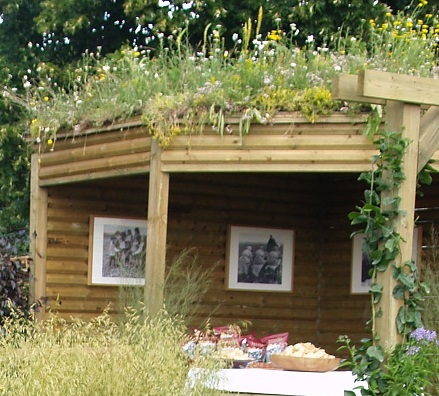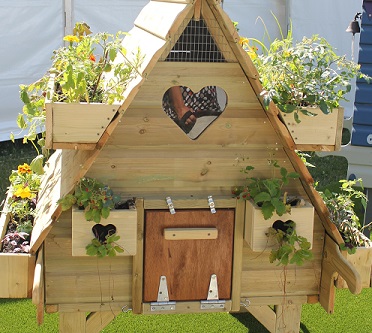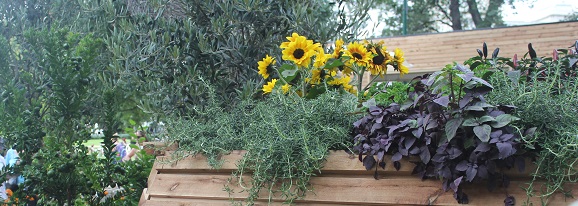How to Build a Green Roof
 Growing plants on a roof has lots of benefits, both aesthetic and practical; but it can also be a little tricky. The last thing you want to do is destroy a building in the process of trying to make it look better.
Growing plants on a roof has lots of benefits, both aesthetic and practical; but it can also be a little tricky. The last thing you want to do is destroy a building in the process of trying to make it look better.
A roof garden is quite literally a garden on the roof of any type of building whether it be a dwelling such as a house or apartment block, a commercial premises like an office block or factory, or an outdoor structure like a gazebo, garage, shed or even something as small as a dog kennel!
There are some very well-known roof gardens around the world. For instance, the Roof Garden in Kensington, near central London, UK, is a very notable landmark. The gardens are divided into several themed areas including a woodland garden, Spanish garden, and Tudor garden. They are open to the public and can be booked for weddings and other special events. Remarkably, it is spread over a staggering 6,000m2 - that's one and a half acres!
Of course not many people can boast that sort of roof space, and even if they could it would probably be too costly or impractical to convert it into a garden. If you have any sort of roof space at all though, you might be able to do something with it to make it into a garden.
The most important thing is that the roof is made waterproof before any installation takes place.
How Can Different Types of Roof be used for Gardens?
Most people assume a roof has to be flat to be even considered for garden space. Wrong! There are ways to work with sloped roofs too.
Flat Roofs
There are several ways to turn a flat roof into a garden. One is to use a mat system. Here, the roof is covered with a water-holding material or thin substrate and then a mat layer which contains plants is spread out over the top. A further layer of biodegradable nets can be secured over the surface to hold everything in place. Another option is a substrate system which comprises different layers including moisture mats, drainage boards and filter sheets. These come in rolls and can be cut to size. The substrate for these roofs is often hosed onto the roof before layers are installed. As plants take hold the payers become entwined. A simpler solution, where weight is of little concern, is to simply ensure the roof is waterproof and to place container plants over the surface.
Sloped Roofs
Sloped roofs up to 30° can be adapted as green roofs. Steeper roofs pose too many problems in terms of maintenance and access. Once again, these roofs need to be waterproofed and require an extra barrier which is resistant to root penetration. Because there is a chance that the roof coverings may move under the additional weight, they need to be securely fixed. Also, the roof needs extra support. This may be in the form of abutments to the eaves or elsewhere on the roof. These supports are needed to transfer shear forces due to the extra loads on the roof structure. The design modifications will need to be done by a structural engineer.
Building a Green Roof
A typical green roof is created by installing a series of layers over the top of an existing roof. The types of layers vary slightly depending on whether or not insulation is incorporated into the design. Non-insulated roofs can have any type of system installed. For insulated roofs there are slightly different configurations according to whether the climate is humid or not, and whether the roof is double skin or single skin (warm or cold roof construction). Generally, the insulation has to be strong enough to support the layers above. The layers from bottom up might include:
- Vapour barrier
- Insulation board – sitting on top of metal roof decking.
- Waterproof roofing membrane or substrate over the top of the insulation.
- A drainage core above the roof membrane
- Substrate layer - media or matting
- Plants
The combined weight of the components, when they are saturated with water (e.g. after rain), must be adequately supported by the roof, with no leakage into the building below. Some growing mediums can absorb ten times their original weight or more when wet too, which is another consideration! You may need to consult an engineer, or strengthen a structure.
Types of Green Roof
When it comes to using layering systems, green roofs fall into one of several different types.
Extensive
These are the best solution for roofs which have lower load-bearing capacity and those which were not originally designed for use as roof gardens. They are low maintenance and do not require irrigation. Extensive systems are the cheapest option because they use the thinnest substrate layer with total depth being anywhere from 1 to 15cm and, of course, that means they add the least amount of weight to the roof. Plants suited to these systems are generally low-growing species which can tolerate harsh conditions of strong winds and drought and be left to fend for themselves. These landscapes tend to mimic a natural environment. Typically, they include grasses, herbs, succulents and herbaceous flowering plants.
Intensive
These systems are at the other extreme to extensive systems. They are the heaviest, the most expensive to install, are high maintenance, and require regular irrigation. There is no limit to what can be grown in these systems and all kinds of features may be included such as ponds and furniture. They most closely resemble parks and gardens. The substrate layers are usually up to 50cm deep but can be thicker. The types of plants in these systems can include trees as well as shrubs, lawns and a wide range of other plants.
Semi-intensive
As the name implies, these systems are somewhere between the other two in terms of cost and maintenance. They require some irrigation but not regular watering like intensive systems. The layers are shallower than intensive but thicker than extensive at somewhere around 15 to 25cm. A semi-intensive system can be used for natural landscapes through to relatively formal ones. They can be used to host a range of plants from herbaceous perennials to grasses and groundcovers up to smaller growing shrubs. They are not suited to taller shrubs and trees however.
Dealing with Water
Wherever water and buildings come into contact there is a risk of leakage. Apart from the water seeping in, there could be cracks and other structural problems which develop rendering the building unsafe for use. Any roof intended for a roof garden has to be waterproofed.
Ways of Waterproofing
Waterproofing can be done in various ways but usually refers to the use of sealants that are applied as liquids which then dried to provide a waterproof barrier.
A roof membrane is usually a water resistant sheet that can be rolled out to cover an area and prevent water moving through to the surface below.
Waterproof concrete and 3-ply felt have been tried and failed for waterproofing roofs. Tanking with 25 to 35mm asphalt has been successful provided there is adequate provision to collect and drain off excessive rainwater.
Various roofing materials have been successfully used laid over bituminous membranes (e.g. cement-grano paving).
Some liquid applied materials (e.g. modified hot rubber, elastomeric urethanes) are successfully used to seal a concrete surface. Several layers increase the effectiveness and durability.
Whatever method is used, the barrier should prevent root penetration.
After waterproofing a roof, a visual inspection should be undertaken before installation. It is also a good idea to test a new sealed roof before installing containers and plants. Sometimes large new roofs are sand bagged and flooded to test for leaks.

What Plants to Grow on your Green Roof
Your options will be governed by what type of system you install, the climate, amount of exposure and how much maintenance you might be doing.
Obviously systems with irrigation, windbreaks and deeper soil can support a wider range of plants.
If the roof garden is out of sight, with a shallow depth of soil and depending only on rainwater, you will need to stick with only the hardiest plants that can tolerate periods of extreme weather and dry soil; such as:
- Succulents and low growing cacti
- Any low growing plants from arid or semi-arid areas
- Hardy grasses, lomandra, hardy creepers
You may also be interested in....